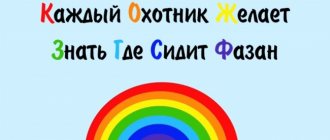MAGAZINE Preschooler.RF
Educational field: communication. Integration of educational areas: “health”, “socialization”. Name of GCD: speech development. Topic: retelling of the fairy tale “The Fox and the Black Grouse.” Correctional and educational tasks: continue to acquaint children with works of oral folk art; consolidate the ability to coherently, consistently, expressively convey the content of a fairy tale without the help of questions from the teacher; convey dialogic speech, changing intonation in accordance with the experiences of the characters; use expressive means (intonation, facial expressions, gestures), learn to notice inconsistencies with the text in retellings to each other, and correctly assess the situation. Correctional and developmental tasks: develop visual and auditory memory, attention; coordination and motor activity; expressiveness of speech, communication skills. Correctional and educational tasks: to cultivate interest in works of oral folk art, self-confidence, and the ability to establish partnerships during a collective retelling. Dictionary: words denoting emotional states - affectionate, frightened, greedy, angry, surprised, alarmed, decree, chilly, photo exhibition, Terentyushko. Demonstration material: image of foxes in different emotional states, easel, shawl for a storyteller, fox and black grouse hats, bibabo fox doll, model of a tree. Preliminary work: reading Russian folk tales with the participation of a fox, looking at illustrations of black grouse, reading G. Skrebitsky’s story “Teteryuk”. GCD move. 1. Organizational moment. - I have a surprise for you guys, we will have a guest for class today. Try and guess who it is. Red-haired cheat, cunning and dexterous. The tail is fluffy, the fur is golden. Lives in the forest, steals chickens in the village. - Why did you decide that it was a fox? (Children's answers) - Let's see if this is so. (Remove the screen, there is a bibabo fox doll on the stand, a camera on her neck) 2. Introductory conversation. - Hello, Lisichka, we are glad to see you. Why did you come to us? - Hello guys. I really love photographing my friends and I want to invite you to my photo exhibition. (Children approach the easel; on the easel there is an image of foxes in different emotional states). - Who is depicted here? -What is the mood of the fox in this photo? What or who do you think she was so afraid of? What was this fox up to? Why do you think this fox was so angry? Why is the fox ashamed? — In which fairy tales is there a fox character? — What is the affectionate name for a fox in fairy tales? (fox, little fox, little fox, little fox - sister, Lisa Patrikeevna) 3. Reading the fairy tale “The Fox and the Black Grouse.” You see, Foxy, how much the guys know about you. And today I want to read you another fairy tale, called “The Fox and the Black Grouse.” You met him in the forest, and the guys and I read a lot about this bird. Sit down and listen with us. 4.Reading the work. 5. Conversation on the content of the fairy tale. - Where did the fox see the black grouse? - What did the fox say when he saw the black grouse? -Why did the fox come up with this decree? - Why did she address him so kindly? — How did Lisa decide to outwit Black Grouse? - Do you think Teterev guessed that the Fox wanted to deceive him? - What did he answer to the Fox? -Who do you think the black grouse meant? Who could walk through the forest? What could he carry on his shoulder? Who to lead? - What did the fox answer? - Why didn’t the fox wait any longer for the black grouse to come down from the tree, but ran home? - Who outwitted whom in this fairy tale? 6. Physical exercise. Let us turn into foxes. One, two, turn around and turn into foxes. The fox has a sharp nose, She has a fluffy tail, A red fox fur coat, Of indescribable beauty I am a bird hunter! I'm an expert at catching chickens! As soon as I see you, I’ll sneak up! And I'll hide quietly. Then I’ll jump and grab it and take it to the kids in the hole. (Repeat 2 times) 7. Repeated reading of the fairy tale and retelling it by children. Now I will read you the fairy tale “The Fox and the Black Grouse” again. And you listen carefully, remember and try to tell it yourself. 8. Dramatization of a fairy tale. To make it interesting for Chanterelle to listen to you, let us not only tell her, but also show her. - Who wants to be a Fox? Who is Grouse? Who is the storyteller? - How will you talk to the black grouse at the beginning of the fairy tale? (affectionately, insinuatingly) - And like at the end of the fairy tale (hurriedly, scared) - And how did the black grouse answer the fox? (calmly, confidently) (Retell the fairy tale twice. When evaluating stories, pay attention to the completeness of the content conveyed, the expressiveness of intonation). 9. Result of GCD. - You liked it. Foxy, are you visiting us? - I liked it very much. I listened to you - as if I had been to the theater and decided: I will not be a photographer, but I will be an artist. I’ll leave you my photos. So that they don’t forget me Brodich Tatyana Nikolaevna. Teacher of the speech therapy group at MBDOU No. 24 “Cosmos”| Next > |
Class
Subject. Development of coherent speech
Goal: learning to retell; expansion and activation of vocabulary; formation of an internal retelling plan; development of attention, memory, logical thinking.
Equipment:
magnetic board (composition board); subject picture “Summer” and subject pictures: Masha, house, flowerbed, chickens, rooster, cow, kitten; card with exclamation mark.
Note. Teachers should supplement the set of pictures with a card with an exclamation mark, which will indicate sentences reflecting the assessment of events and attitude to what is happening. For example: Masha likes to relax with her grandmother. “What a beautiful fish.” - thought Masha. Goodbye! and so on.
Progress of the lesson
The teacher attached pictures from top to bottom, one under the other, to a magnetic board (typesetting board), and read the text:
- The long-awaited summer has come. Masha went to visit her grandmother in the village. Grandma has a big beautiful house. Under the windows there is a flower bed with flowers. Variegated chickens roam around the yard. An important rooster is watching over them. The cow Zorka moos for a long time. A small gray kitten yawns and squints on the porch. Masha likes to relax with her grandmother.
Pointing to each picture in turn, the teacher asks the children to remember what was said in each sentence. Then the children retell the entire text in a chain. At the end of the retelling, the teacher turns the pictures over one by one and invites one of the children to reproduce the content of the story.
This arrangement of pictures is explained by the fact that at subsequent stages not only object pictures (denotations) are used, but also graphic schemes of sentences.
Note. If difficulties arise, the child can turn the picture over and, using visual support, restore the content of the sentence.
After a successful retelling, you can turn all the pictures over. The number of cards on the board will correspond to the number of sentences in the text.
Note. Please note that the texts will contain sentences with homogeneous members. In this case, two pictures can be located in one row. And the number of sentences in the text will correspond to the number of rows of pictures. At the end of the lesson or the next day, a more complex type of work is carried out. Pictures for the story are displayed in free order on the board. The teacher reads the text and after reading asks one of the children to arrange the pictures in the desired sequence. All children help and monitor the correctness of the task. After which you can repeat the retelling of the entire text again.


